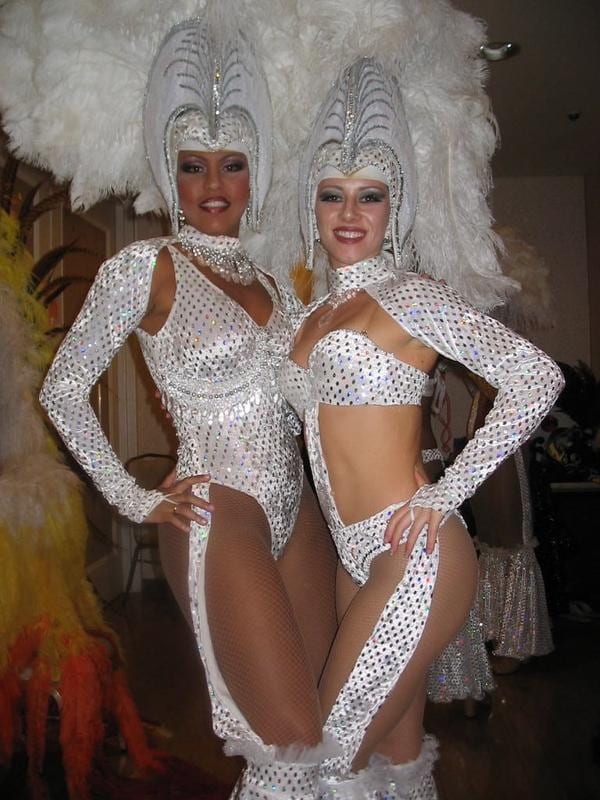My Time as a Brazilian Passista

The author, Anna Else Pasternak,(on the right) poses in her beaded thong and exaggerated headpiece with a fellow Brazilian passista. Photo courtesy from Anna Else Pasternak
Although my behind is not all that curvaceous and I lack melanin in my skin tone, I somehow managed to pass for as a mulata passista.
I am neither mulata nor a trained passista—a young woman, generally with a tiny outfit and curvy physique, who usually dances in front of the bateria during Rio´s carnival parade. I was a Harvard sophomore studying abroad in Rio de Janeiro and my training in ballet, modern and world dance had taught me a little something about my new job.
It was more important to the Japanese audience and the Brazilian managers that I was able to sell the Brazilian national dance—samba. That is exactly what I did for three months in hotels, theaters and amusement parks throughout Japan. Most of the official mulata passistas in the samba troupe travel to Japan every year, since professional samba dancers have little work outside of carnaval season in Rio de Janeiro. I arrived, however, on a whim to the troupe´s audition. There, I encountered a sea of silicon breasts and buttocks. This was quite an astounding and somewhat intimidating scene to happen upon after years of dancing with bony and underfed ballet and modern dancers, but I loved the scene and was thrilled when I was accepted.
My two months as a Brazilian passista not only taught me a great deal about samba, Brazil, Japanese mariachi bands and the names of thirty different types of seaweed, but also made me really question the identification and creation of popular culture. Dance and other art forms are used quite frequently among nation-states to create a national identity and unity among their people. Brazil has been particularly successful at nationalizing many such artistic expressions such as samba and capoeira. What has always interested me is the process of creating a national or popular culture. What is popular culture after all? Is it what some Brazilians enjoy doing or rather what can be sold abroad…or perhaps a little mixture and tweaking of both? In my time as a passista, I peddled a commercialized performance created to show the public transcript of Brazilian popular culture to Japan.
I traded in my leotards, bare feet and technical modern dance styles for a beaded thong, four-inch heels, exaggerated headpiece and fake smile. I transformed my Californian self into a certain kind of Brazilian—the stereotypical and commercial one that Japan and the tour managers wanted to see. We did not perform the samba no pê, the spontaneous movement improvised in gatherings throughout Brazil. This was a dance preprogrammed and perfected to the point that the improvisation and African roots of the samba were extracted, creating a new kind of experience.
I should not be surprised, given the new manifestations of dance emerging around the world as a result of increased contacts of different dance forms. Afro-Cuban modern emerged in the late 1950s and Afro-Silvestre has become increasingly popular in Brazil. Both dance forms syncretize Graham, Humphrey and Limón techniques (North American modern dance) with African beats and movements. Hence, our Las Vegas samba show—equipped with snippets from the Phantom of the Opera and segments in fake leather costumes, dancing to a lip-synching Cher acted out by our resident drag queen, Jadson—should be seen as completely normal. After all, dance can be commercialized to sell. However, after being educated at the San Francisco School of the Arts in ballet, modern, contemporary and world dance, with emphasis on the intellectual and spiritual side of dance, this “selling” aspect was hard for me to accept.
Dance had always been my Eros. It was something I did to linger in a threshold between this world and another. The last thing I saw myself doing was a Las Vegas-type commercial show. I felt as if I were betraying the feeling behind dance and being dishonest with my reasons for loving the art form. Lingering in my subconscious was the idea of ¨selling out,¨ yet going commercial means financial perks and more job options. In my case it meant one of the most interesting experiences of my life.
I arrived the first day of rehearsal in Rio de Janeiro, thinking I had gone to the wrong practice and was instead the next star of Flashdance. While being able to execute some complex samba steps was important to the samba troupe which had recently hired me, it did not seem to be quite as necessary as my ability to rebolar, requebrar and generally mexer my body. In other words, the most pertinent element of the show was the dancers´ ability to shake their booties and gyrate at dangerous speeds. In the three hours that we paraded each stage in Japan, only ten minutes were devoted to a samba routine. During the rest of the two hours and fifty minutes, the Phantom of the Opera was sung, Jadson (the drag queen) did a striptease across the laps of the Japanese businessmen in a Carmen Miranda outfit (appropriate, given Miranda´s controversial image as a commercial sell-out) and the director of the show belted out the famous lyrics ¨Brasil…homem de negocios [businessman] …Brasil, Brasil…¨ Our gyrating was good for one thing: the chopsticks. These were no ordinary chopsticks, however: between the two pieces of frayed wood were crisp 10,000 yen notes. At first I was disgusted by the idea that these Japanese men, women and children would strategically stick these chopsticks into our bikinis and tops as a token of their appreciation. I was a trained dancer, not a stripper! The more I whipped my waist around in circles, the more yen I had coming out of my ¨fio da morte¨ (literally, string of death, and what the other dancers liked to call the way we had to wear small pieces of string between our legs and around our tights and bikinis as to hide material that might want to protrude in inappropriate directions as well as lessen the risk that we might lose our bikinis to the floor). We became chopstick hounds. Most dance companies and dancers live a life absorbed by competition and these chopsticks only added a whole new level of intensity to the already competitive environment.
Altogether, a month traveling with nine Kenyan human pyramid makers, two Japanese comedians and a Japanese mariachi band with matching mini-mustaches, cowboy boots and gold studded suits created a hilarious spectacle for the citizens of the cities where we performed. For the first week our eclectic group traveled marvelously together. At first I acted as translator jumping between each group with a little bit of English, Spanish and Portuguese here and there. Later on, performers seemed to have claimed their spots on the bus and stuck to their side of the lunch buffets. The rice and beans were on the left for the Brazilians and the rice and eel on the right for the Japanese. The Kenyans—and I—picked from both sides of the table.
While I peddled commercial samba and a stereotypical Brazilian image, the Kenyans were selling a stereotypical image of Africa. In revealing animal print outfits the Kenyans jumped through burning hoops and climbed on top of each other to make impressively dangerous human pyramids. They confessed to me that the pre-recorded drum music played throughout the show was from South Africa. I guess it didn´t matter. They wore their animal prints and danced around to drum beats which was the Africa the audience wanted to see and the Africa the performers were willing to present as their public transcript. Mexico is not just mariachi and Brazil is more than thongs and samba, but what pays the dancers and artists unfortunately tends to be the commercial, or perhaps, in our case, just the thongs.
Our trip continued to the town of Hamamatsu, where street signs were always written in Japanese and Portuguese due to the large Brazilian community of Japanese descent contracted to work in the car factories of the region. While the Brazilian women I was with went to great lengths to chemically straighten their naturally kinky hair, here in Hamamatsu the Japanese girls went to even greater lengths to rat and and curl their hair to resemble that of the Brazilians. In the local bath-houses, it was a competition to see who could keep their hair the driest. The Brazilian girls dared not get their hair wet in fear of a return to curls and the Japanese sat just up to their waist in the pools as to not ruin their artificially inflated hairdos.
During my time as a passista, perhaps I was only helping to instill a stereotype just as the Kenyan acrobats only reinforced a stereotypical Africa, and the mariachi band a stereotypical Mexico. I was hired to present an image of a place and its people created and exported by show managers in positions of power. Those presenting the public image had no say in its production, nor did it really matter if they hailed from the places they represented. Brazil, Kenya and Mexico were sold as cute, tidy and amiable party favors. And all the while we dancers were busy gyrating and grinning away for a few extra chopsticks.
Related Articles
Disruption in the Immigrant Experience: Colombian Youth Dance Their Way to Continuity
Imagine you are fifteen years old. As an immigrant who has lived in the United States for a few years, you are still trying to find your place. You decide to join a group that dances the traditional dances of your country. You practice every week on Fridays, when you could be going to the movies or hanging out with your friends. Your goal is to perform in that big annual show a lot of people have told you about. That day has finally …
Review of Connecting Lines: New Poetry from Mexico
Lou Dobbs and other talk show hosts want us to believe that a so-called Mexican invasion is denying “true” Americans their jobs, democracy and destiny. Few among them comment on a peaceful, more subtle Mexican “invasion” that will help us see why fears of blending Mexican and U.S. culture are misplaced. One by one, since the turn of the century, anthologies of a Mexican poetry trumpeting innovation and diversity have been …
Review of The Hispanic World and American Intellectual Life, 1820-1880
Iván Jaksić’s highly original and engaging scholarship on the origins of U.S. academic interest in Ibero-America brilliantly reveals previously unknown trans-Atlantic and Western hemisphere intellectual networks. His research focuses on the life, interactions and contributions of those Jaksić calls“the pioneer American scholars and lifetime students of the Hispanic World”—Washington Irving, George Ticknor, Henry Wadsworth …




